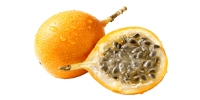Yellow Grenadilla

Yellow Grenadilla Homeland of this plant, as well as other types of passionflower, are the subtropical and tropical zones of America - Brazil. Currently, fruits of the yellow passion flower are grown in Central and South America, Africa, Asia, Australia, New Zealand and the USA (California and the Hawaiian Islands). As an ornamental plant, passionflower with its varieties is massively occupying new territories in the warm regions of Europe, and as a houseplant, it is gaining more and more popularity in our country as well.
The yellow grenadilla takes second place after the purple grenadilla and is massively grown in Brazil, Venezuela, Bolivia, as well as in Africa - Kenya, Tanzania, Israel, Sri Lanka and the Hawaiian Islands. The largest producer of fruits of this variety is Brazil, where there is a record number of varieties - over 150. The popularity of the yellow grenadilla is mainly due to its high fertility and resistance to a number of diseases.
The plants are climbing, with thin stems and alternating green and broad leaves. The fruits have a rounded oval or oval shape and are larger than those of its older sister, the purple grenadilla. They are 9 to 12 cm long, 5-7 cm in diameter and weigh 60-100 g. The color of the skin is bright yellow, and the flesh of the fruit is yellow-green. The taste is reminiscent of the taste of the purple grenadilla, but a little more sour.
Depending on the region where the fruits are grown, so is their name: Brazilian, Venezuelan or Hawaiian passion fruit. They are rich in vitamin C. The fruits are used for food in fresh form or as a component of exotic fruit salads, but mainly juices, nectars, soft drinks are prepared from them, as well as additions to liqueurs and ice creams. The preservation of the fruits after picking usually lasts from 3 to 5 weeks when stored at a temperature of 11.5-12.5 degrees and a relative humidity of 85%. Stored at lower temperatures can quickly rot. Passion fruit plants are grown in a bright, sunny, warm and airy location in a rich peat soil mixture. Propagation is done by cuttings in March and April, which are rooted in warm soil at a temperature not lower than 20 degrees.


